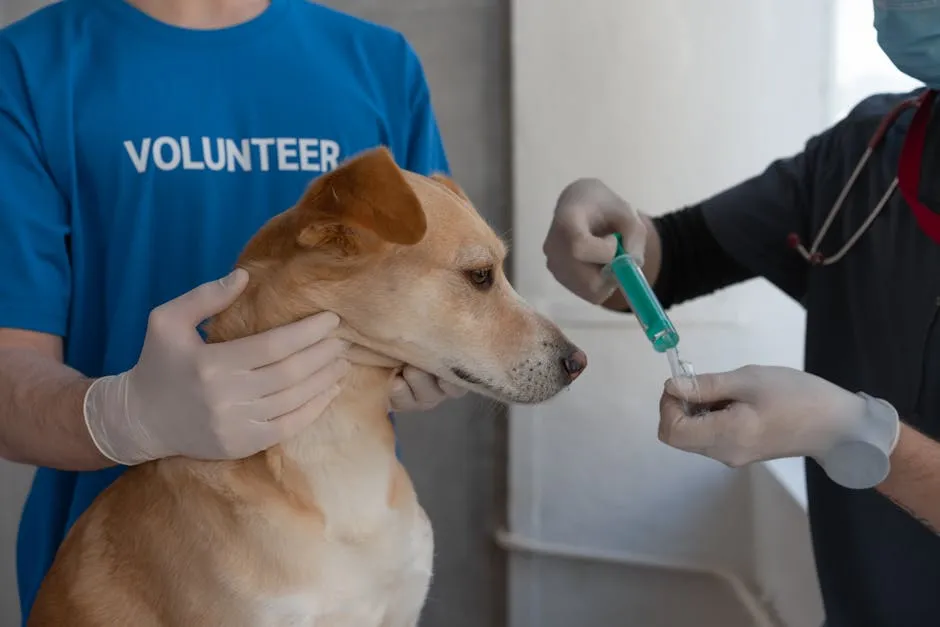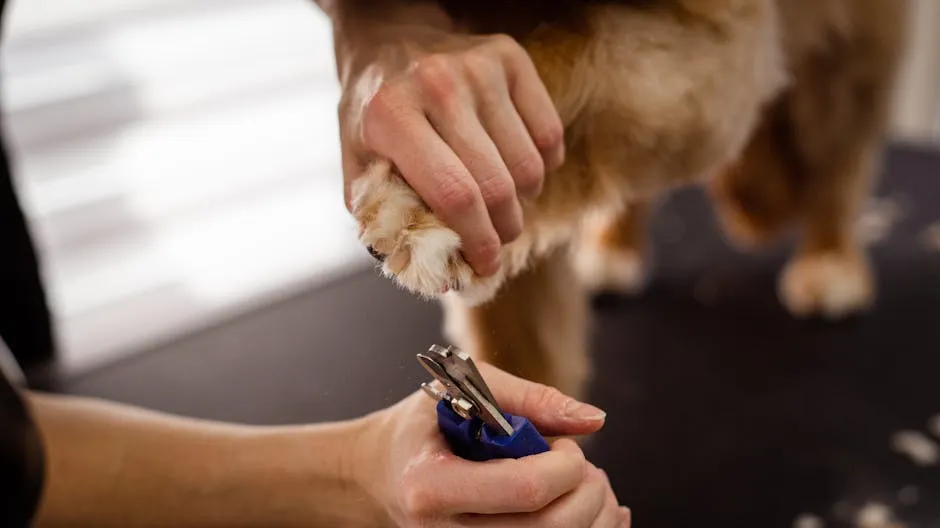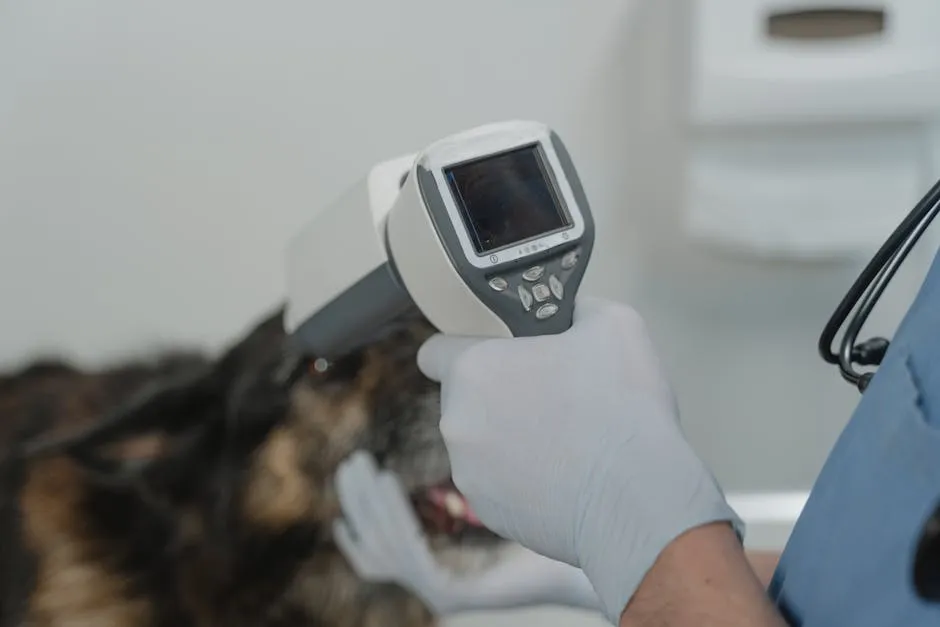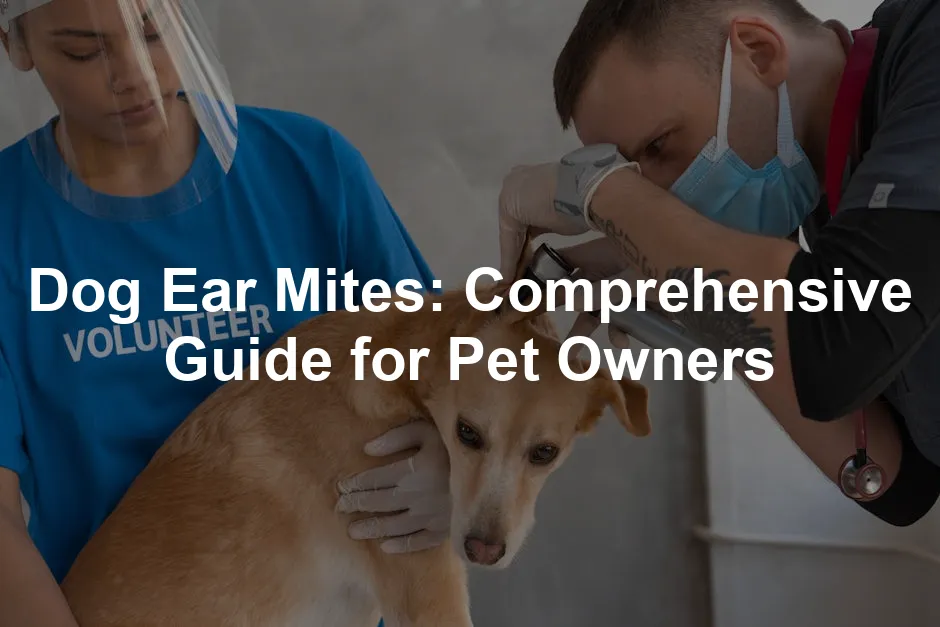Introduction
Have you noticed your dog scratching their ears more than usual? If so, ear mites could be the culprit. These tiny parasites, known scientifically as Otodectes cynotis, thrive in your dog’s ear canal. Though they aren’t life-threatening, they can cause significant discomfort and irritation.
Recognizing ear mites early is crucial. If left untreated, they can lead to complications like secondary infections. Puppies are particularly prone to these infestations, so keeping a close eye on their ear health is essential. To maintain your dog’s overall hygiene, consider using a Pet Ear Cleaner Solution. It makes cleaning their ears a breeze and helps prevent pesky infestations!

Summary and Overview
Ear mites, scientifically classified as Otodectes cynotis, are small parasites that primarily inhabit the ear canal and skin of your dog. They feed on the wax and oils found in the ear, leading to irritation.
Signs of an infestation include intense itching, head shaking, and dark, waxy discharge resembling coffee grounds. If ignored, ear mites can cause secondary infections, resulting in further complications. For a thorough cleaning, consider using Dog Ear Wipes that make ear cleaning easy and effective!
Veterinary diagnosis is essential for appropriate treatment. Your vet can confirm the presence of ear mites and rule out other issues. Preventative methods, such as regular ear cleaning and flea control, can help keep these pesky invaders at bay. For a more in-depth understanding, you can refer to our comprehensive guide to ear mites in dogs.
Understanding ear mites and their impact on your dog’s health is crucial. Learn more about ear mites in dogs.

Understanding Ear Mites
What Are Ear Mites?
Ear mites are microscopic parasites that are often difficult to see without specialized equipment. They measure about 1-2 millimeters in length and appear as tiny white specks.
Their life cycle is fascinating. After laying eggs, they hatch within four days. The young mites mature into adults in about three weeks, with a lifespan of roughly two months. Unlike some parasites, ear mites do not burrow into the skin but thrive on the surface.
These pests are highly contagious and can easily spread among animals through direct contact, making it vital to treat all pets in a household simultaneously. You can help your furry friend stay comfortable with Dog Shampoo for Itchy Skin that soothes and cleans, helping to prevent infections!

How Dogs Get Ear Mites
Transmission Methods
Ear mites are highly contagious. They spread easily through direct contact with infected animals. If your dog plays with another dog that has ear mites, they may quickly become infested. This transmission happens commonly in multi-pet households.
Kennels and shelters are also hotspots. Many animals in close quarters can facilitate the spread of these pesky parasites. Dogs that frequently interact with other pets are at higher risk. Keeping your dog’s environment clean is essential; a Pet First Aid Kit can be a lifesaver in case of emergencies!
Outdoor exposure increases the chance of infection. Dogs that roam freely or visit parks often come into contact with other animals. Social interactions contribute significantly to the spread of ear mites.

Symptoms of Ear Mites
Signs to Look For
Watch for these common symptoms: scratching, head shaking, dark discharge, and an unpleasant odor. Dogs with ear mites often scratch their ears excessively. You might notice them shaking their heads frequently, trying to relieve discomfort.
Puppies and older dogs may exhibit different symptoms. Puppies typically show more intense itching, while older dogs might have a more subdued response. To ensure your dog’s comfort, consider investing in a Dog Bed that provides a cozy resting spot!
Look for signs of secondary infections. If your dog’s ears appear red or swollen, seek veterinary help promptly. Ignoring these signs can lead to more serious health issues.

Diagnosis of Ear Mites
Veterinary Procedures
Veterinarians diagnose ear mites through specific examination techniques. They often use an otoscope to inspect your dog’s ears closely. This tool allows them to see inside the ear canal.
In some cases, a cytology test is performed. This involves taking a sample of ear debris and examining it under a microscope. Identifying ear mites helps confirm the diagnosis.
Ruling out other conditions is crucial. Infections or allergies may cause similar symptoms. A thorough examination ensures your dog receives the right treatment. Don’t forget to keep your dog well-groomed; a Dog Grooming Kit can help you maintain their coat and reduce the risk of ear issues!

Treatment Options for Ear Mites
Veterinary Treatments
If you suspect your dog has ear mites, visiting the vet is essential. They will likely recommend several treatment methods.
First, ear cleaning is crucial. This process removes debris and allows medications to work effectively. Your vet may use specialized ear cleaners to flush out the ear canal. If you’re looking for a great ear cleaning solution, you can try a Dog Ear Cleaner that makes the job easier!
Topical medications are the next step. These can be applied directly into the ear canal. They usually contain insecticides that target mites. Some vets might suggest injectable medications, like ivermectin, if oral or topical treatments aren’t effective. You can find Ivermectin Tablets for effective treatment.
Oral medications may also be recommended. These can help eliminate mites throughout your dog’s body.
It’s vital to treat all pets in your home at the same time. Ear mites can easily spread among animals. If one pet is infected, others might be too.
Follow-up appointments are necessary to ensure complete elimination. Mites have a life cycle of about three weeks. Your vet may want to check your dog again to confirm that the infestation is gone.

Preventing Ear Mites
Best Practices for Prevention
Preventing ear mites is often simpler than treating them. Regular ear cleaning is a good start. Clean your dog’s ears weekly to reduce wax buildup and prevent infestations.
Consider preventive medications, like flea and tick treatments. Some of these products also combat ear mites. Discuss suitable options with your vet to find the best fit for your pet. For effective flea control, check out Pet Flea and Tick Treatment options that work wonders!
Keep your dog away from other animals that might be infested. Avoiding contact with other pets, especially in places like parks or kennels, reduces risk.
Also, maintain a clean environment. Wash your dog’s bedding regularly to eliminate any lingering mites. Vacuum carpets and furniture where your dog spends time.
By following these best practices, you can help keep your furry friend safe from ear mites. And speaking of safety, consider a Dog Safety Harness for those outdoor adventures!

Recovery and Management
Post-Treatment Care
After treatment, monitor your dog for signs of recovery. Most dogs show improvement within a few days. However, complete eradication can take up to 30 days.
Watch for any concerning signs. If your dog continues to scratch or if the ears appear red and swollen, consult your vet. These could indicate a secondary infection or that the mites are still present.
Maintaining a clean environment is crucial post-treatment. Regularly wash bedding and toys to prevent reinfestation. This also helps keep your dog comfortable during recovery. To keep their toys engaging, consider getting a Dog Puzzle Toy that keeps them entertained!
With proper care and attention, your dog can recover fully from ear mites.

Conclusion
Timely diagnosis and treatment of ear mites are crucial for your dog’s comfort and health. Ignoring these pesky parasites can lead to severe complications, including painful infections. Regular veterinary visits help catch such issues early on.
As a responsible pet owner, maintaining preventive measures is key. Regular ear cleaning and appropriate treatments can keep ear mites at bay. Always consult your veterinarian for accurate diagnosis and effective treatment options. And to ensure your dog stays hydrated during the day, consider a Pet Water Fountain that encourages them to drink more!
Your dog relies on you for their health. Stay vigilant, and ensure they live a comfortable, happy life free from ear mites.

FAQs
Can ear mites cause permanent damage to my dog’s ears?
Yes, untreated ear mites can lead to serious complications. These include secondary infections that might damage the ear canal or eardrum. In severe cases, they can even lead to hearing loss. Early detection and treatment are essential to prevent lasting effects.
Are ear mites contagious to humans?
Ear mites are rarely contagious to humans. In very rare cases, they may cause a temporary rash or itchiness. However, the mites that infect dogs differ from those that affect humans, making transmission quite uncommon.
How can I tell if my dog has ear mites or another ear issue?
Symptoms of ear mites often include intense scratching, dark discharge, and head shaking. However, other conditions like infections or allergies can cause similar symptoms. A veterinarian can perform an examination and tests to confirm the presence of ear mites and rule out other issues.
What home remedies can help with ear mites?
Some pet owners may seek home remedies for ear mites. While options like olive oil or apple cider vinegar exist, they often provide limited relief. These remedies might soothe symptoms but do not eliminate the infestation. Professional treatment remains essential for effective results. Your veterinarian can prescribe targeted medications that directly address ear mites. Remember, effective treatment is key to preventing secondary infections and further discomfort.
How long does it take to treat ear mites in dogs?
Typically, treating ear mites in dogs takes about three weeks. This duration includes the life cycle of ear mites, which lasts around 21 days. During treatment, adult mites are killed, but eggs may still hatch. Therefore, follow-up care is crucial. Factors such as your dog’s overall health and any secondary infections can affect recovery time. If your dog shows persistent symptoms, consult your veterinarian for additional care.
Are certain breeds more susceptible to ear mites?
Certain dog breeds may be more prone to ear mites due to their ear structure. Breeds with floppy ears, like Cocker Spaniels or Basset Hounds, can trap moisture and debris. This environment can promote ear mite infestations. However, any dog can contract ear mites, especially in multi-pet households or shelters. Regular ear checks and grooming can help minimize the risk, regardless of breed.
Can I prevent ear mites with regular grooming?
Yes, regular grooming plays a vital role in preventing ear mites. By cleaning your dog’s ears weekly, you can reduce wax buildup and detect early signs of infestation. Look for any unusual discharge or irritation. Additionally, grooming helps maintain overall ear health. Consider using a vet-approved ear cleaner during your grooming routine. Keeping your dog’s ears clean and dry is essential for early detection and prevention of ear mites.
Please let us know what you think about our content by leaving a comment down below!
Thank you for reading till here 🙂
All images from Pexels





